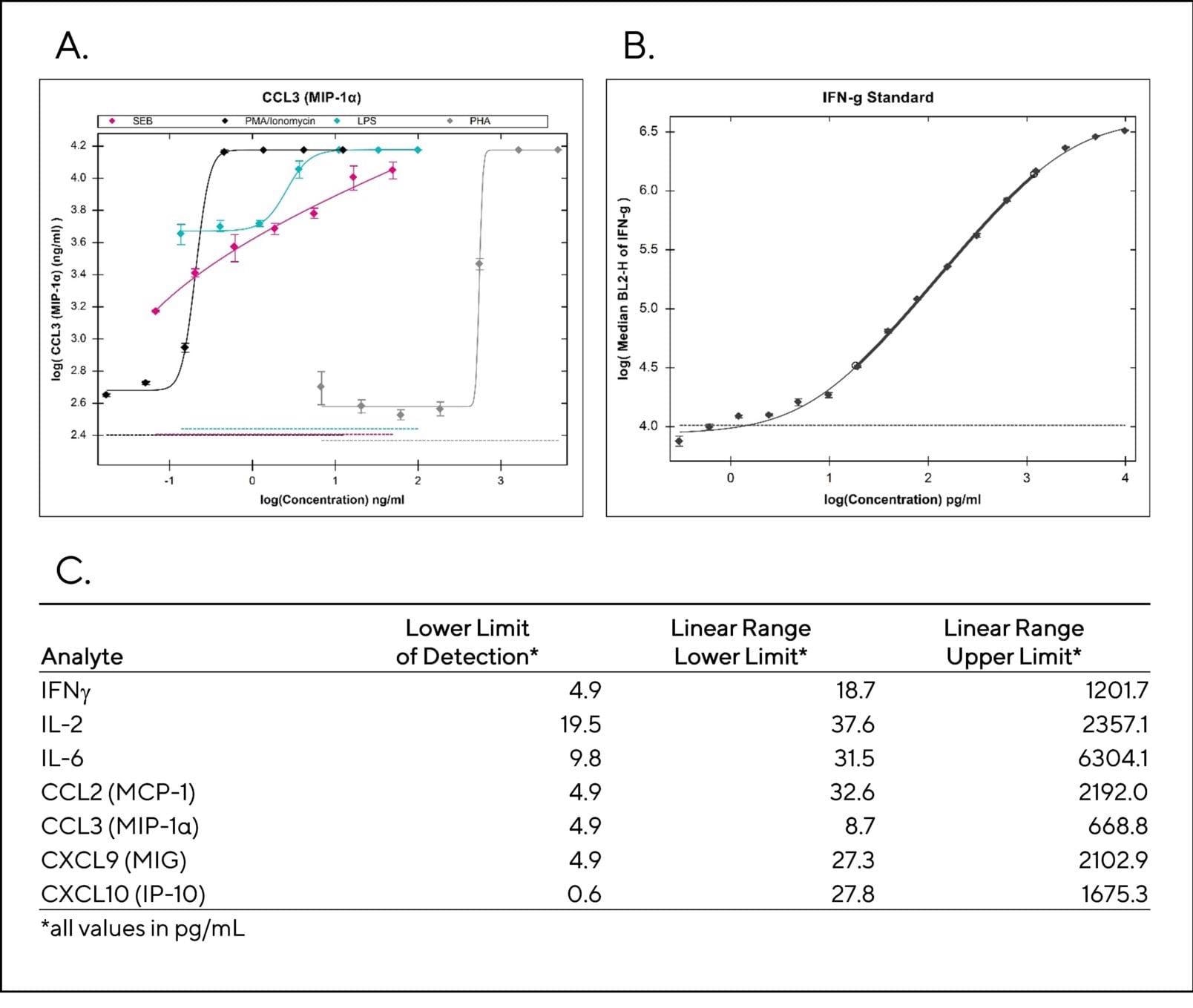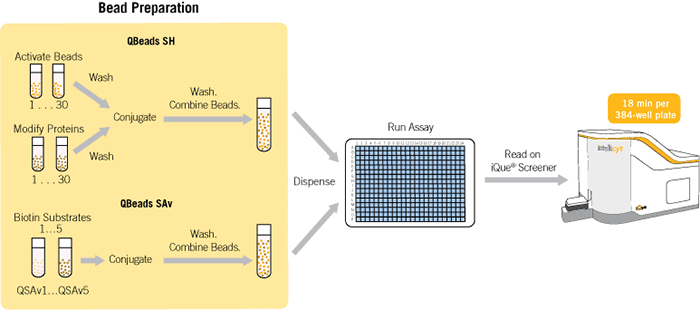iQue Qbeads® is considered a family of reagents allowing the capture of particular proteins on separate bead types. This permits multiplexed quantitation of adhesion molecules, cytokines, enzymes, growth factor receptors, and more.
These kits have been specifically developed and improved for use on the iQue Screener platform to offer a combined solution with the special advantages of fast time to results, high content, microvolume-assays, and low cost. Qbeads kits come in various sizes to fulfill the research requirements of users.
Available iQue® Immunoassay Kits include:
iQue Qbeads® PlexScreen:
These kits are complete, custom-built, and ready-to-run — including everything that users require to run their assay. Every kit consists of several compounds like detection reagents, capture beads, buffers, standard proteins and a template for analysis. Sartorius provides PlexScreen kits for mouse, human and rat secreted proteins.
iQue Qbeads® devScreen:
These are capture beads that have been designed specifically to help scientists examine their special or proprietary proteins of interest. Two categories of DevScreen beads are available, with diverse surface chemistries.
iQue Qbeads® PlexScreen
The iQue Qbeads® PlexScreen family of reagents are custom-made into comprehensive ready-to-run kits. The kits include beads to capture mouse, human or rat secreted proteins, detection reagents, buffers, standard protein and analysis templates. Every analyte has been verified in no-wash and 1-wash protocols.
Key benefits
- No-wash protocol - Users can just add and read for a quick and easily automated workflow. They can see the workflow diagram below.
- Up to 30 analytes can be examined at the same time, with no decrease in analysis speed.
- Comes with the mouse, human, and rat secreted proteins like chemokines, cytokines, enzymes, and growth factors.
- Custom-built to users’ orders, flexibility is maximized.
- Users can multiplex with other MultiCyt kits like Cell Membrane Integrity for better content.
Workflow

Image Credit: Sartorius UK Ltd
Build Users’ custom Qbeads PlexScreen kit
Qbeads PlexScreen is known as a family of reagents that utilizes immunochemistry to capture particular secreted proteins on diverse bead types. Sartorius provides beads for human, mouse, and rat secreted proteins. Below is a list of analytes that could be screened.
iQue Qbeads® PlexScreen: Human secreted proteins
Table 1. Source: Sartorius UK Ltd
| Cytokine |
| Chemokine |
TNF |
Interleukin |
| CCL2 (MCP-1) |
TNF (TNFα) |
IL-1α |
IL-10 |
| CCL3 (MIP-1α) |
sCD154 (sCD40 Ligand) |
IL-1β |
IL-11 |
| CCL5 (RANTES) |
CD178 (Fas Ligand) |
IL-2 |
IL-12/IL-23(p40) |
| CCL11 (Eotaxin) |
TNFβ (LT-α/TNFSF1) |
IL-3 |
IL-12(p70) |
| CD14 |
90563 |
IL-4 |
IL-13 |
| CXCL9 (MIG) |
|
IL-5 |
IL-17A |
| CXCL10 (IP-10) |
|
IL-6 |
IL-17F |
| CXCL11 (I-TAC) |
|
IL-7 |
IL-21 |
CX3CL1
(Fractalkine) |
|
IL-8 |
IFN-α |
| |
|
IL-9 |
IFN-γ |
| Receptor |
Adhesion Molecule |
Growth Factor |
Enzyme |
| CD121a (IL-1 RI) |
CD54
(ICAM-1) |
Angiogenin |
Granzyme A |
| CD121b (IL-1 RII) |
CD62E
(E-Selectin) |
Basic FGF |
Granzyme B
|
| TNFRI |
CD62L
(L-Selectin) |
CSF2 (GM-CSF) |
|
| TNFRII |
CD62P
(P-Selectin) |
CSF3 (G-CSF) |
|
| |
CD106
(VCAM-1) |
VEGF |
|
iQue Qbeads® PlexScreen: Mouse secreted proteins
Table 2. Source: Sartorius UK Ltd
| Cytokine |
| Chemokine |
TNF |
Interleukin |
| CCL2 (MCP-1) |
TNF (TNFα) |
IL-1α |
IL-12/IL-23 (p40) |
| CCL3 (MIP-1α) |
|
IL-1β |
IL-12(p70) |
| CCL4 (MIP-1β) |
|
IL-2 |
IL-13 |
| CCL5 (RANTES) |
|
IL-3 |
IL-17A |
|
CXCL1 (KC;GROα)
|
|
IL-4 |
IL-17F |
| CXCL9 (MIG) |
|
IL-5 |
IL-21 |
| |
|
IL-6 |
IL-23 (p19/p40) |
| |
|
IL-9 |
IFN-γ |
| |
|
IL-10 |
|
| Growth Factor |
Adhesion Molecules |
| CSF2 (GM-CSF) |
CD62E (E-Selectin) |
| CSF3 (G-CSF) |
CD62L (L-Selectin) |
iQue Qbeads® PlexScreen: Rat secreted proteins
Table 3. Source: Sartorius UK Ltd
| Cytokine |
| Interleukin |
TNF |
| IL-1α |
TNF (TNFα) |
| IL-2 |
|
| IL-4 |
|
| IL-10 |
|
| IFN-γ |
|
iQue Qbeads® human inflammation panel kit
The measurement of seven human cytokines and chemokines from either serum or in vitro samples is made possible by the Human Qbeads Inflammation Panel Kit. The chemokines or cytokines are implicated in inflammatory responses to disease states such as chronic inflammation, autoimmune diseases, and infections. This involves viral infections like COVID-19.
Analytes provided in the Human Qbeads Inflammation Panel Kit include Human Interferon gamma (IFNγ), CCL2 (MCP-1), Interleukin-2 (IL-2), Interleukin-6 (IL-6), CCL3 (MIP-1α), CXCL10 (IP-10), and CXCL9 (MIG).
Key benefits
- Pre-configured panel to measure seven compatible analytes at the same time just by using only 10 μL of sample.
- User-friendly kit validated with 1-wash protocol.
- Developed for high-throughput applications. Comes in 384-well format.
- Flexibility available to add compatible analytes from Qbeads portfolio, with no decrease in speed analysis.
Workflow

Image Credit: Sartorius UK Ltd
Table 4. Source: Sartorius UK Ltd
| iQue Qbeads® Human Inflammation Panel Kit Ordering Information |
| Platform |
Compatible with iQue® 3/iQue® Screener Plus – BR and VBR Configurations |
| Available Sizes |
Catalog Numbers |
| 1 x 384 wells |
97097 |
| 5 x 384 wells |
97098 |

Figure 1: (A) Concentration-dependent increase in cytokine expression after 24 hours stimulus with various chemicals. Human peripheral blood mononuclear cells (PBMCs) were treated in culture with either Staphylococcal Enterotoxin type B (SEB), Phorbol 12-Myristate-13-Acetate/lonomycin (PMA/Ionomycin), Lipopolysaccharide (LPS), or Phytohaemagglutinin (PHA) and cytokine secretion was measured with the Intellicyt® Human QBeads Inflammation Panel. Example data for CCL3 (MIP-1α) shown. The dashed lines represent the fluorescent background when the treatment concentration is zero. (B) Representative standard curve for IFNy. The bold lines indicate the linear range in each graph, with the detection range wider than the linear range. The dashed line represents the fluorescent background when the standard concentration is zero. (C) Lower Limit of Detection (LLOD), Linear Range Lower Limit, and Linear Range upper Limit for each analyte. LLOD was calculated by adding 3 standard deviations to the mean of samples without the analyte (n=12). Linear ranges were determined by ForeCyt® software using 4 parameter logistic (4PL) curve fit with 1/Y2 weighting. Image Credit: Sartorius UK Ltd
iQue Qbeads® DevScreen
The Qbeads DevScreen family are considered bead-based kits that offer users high flexibility to make their own bead-based multiplex assays. There are two kinds of DevScreen kits classified based on their surface chemistries:
iQue Qbeads® DevScreen SAv: These are streptavidin-coated beads that can be utilized to screen with biotinylated targets. There are five different SAv-coated bead populations and these could be multiplexed with any analytes available from the PlexScreen panel and with the DevScreen SH panel.
iQue Qbeads® DevScreen SH: These are beads derivatized along with sulfhydryl groups. These beads provide highly flexible chemistry that could covalently bond an extensive range of molecules. There are around 30 sulfhydryl beads and these could be multiplexed with Qbeads PlexScreen as well as Qbeads DevScreen SAv reagents.
Key benefits
- Comes with sulfhydryl or streptavidin surface chemistries available for flexibility in coating beads with molecules of interest.
- Multiplex with other MultiCyt kits such as Qbeads PlexScreen kits for richer content.
- Users can plex up to 30 for higher content; quick analysis time is not affected by the size of the plex.
Workflow

Image Credit: Sartorius UK Ltd
Build Users’ Custom Qbeads DevScreen Kit
The iQue Qbeads® DevScreen family of reagents are so-called “make your own” products that provide high flexibility in their assay. There are two kinds of DevScreen reagents named depending on their surface chemistries.
iQue Qbeads® DevScreen: SAv (Streptavidin)
Table 5. Source: Sartorius UK Ltd
| Catalog Number |
Description (1x384 wells) |
| 90748 |
QSAv1 |
| 90752 |
QSAv2 |
| 90756 |
QSAv3 |
| 90760 |
QSAv4 |
| 90764 |
QSAv5 |
| 90776 |
QSAv2 & 4 |
| 90780 |
QSAv2, 3 & 4 |
| 90788 |
QSAv1, 2, 3 & 4 |
| 90792 |
QSAv1, 2, 3, 4 & 5 |
iQue Qbeads® DevScreen: SH (Sulfhydryl)
Table 6. Source: Sartorius UK Ltd
| Catalog Number |
Description (50x384 wells) |
| 90892 |
QSH01 |
| 90893 |
QSH02 |
| 90894 |
QSH03 |
| 90895 |
QSH04 |
| 90896 |
QSH05 |
| 90897 |
QSH06 |
| 90898 |
QSH07 |
| 90899 |
QSH08 |
| 90900 |
QSH09 |
| 90901 |
QSH10 |
| 90902 |
QSH11 |
| 90903 |
QSH12 |
| 90904 |
QSH13 |
| 90905 |
QSH14 |
| 90906 |
QSH15 |
| 90907 |
QSH16 |
| 90908 |
QSH17 |
| 90909 |
QSH18 |
| 90910 |
QSH19 |
| 90911 |
QSH20 |
| 90912 |
QSH21 |
| 90913 |
QSH22 |
| 90914 |
QSH23 |
| 90915 |
QSH24 |
| 90916 |
QSH25 |
| 90917 |
QSH26 |
| 90918 |
QSH27 |
| 90919 |
QSH28 |
| 90920 |
QSH29 |
| 90921 |
QSH30 |